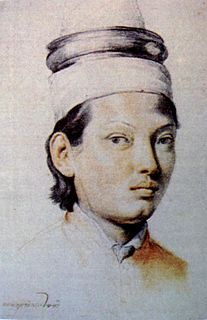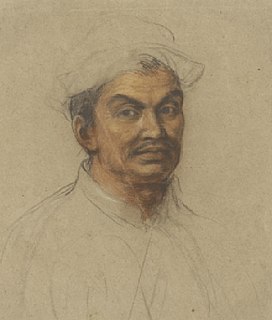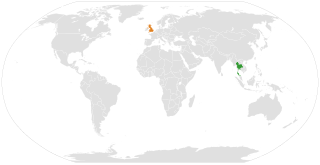Marshal Desfarges, also spelled Des Farges (died 1690), was a French general of the 17th century who took an important role in French efforts at establishing a presence in Siam (modern Thailand).

Thailand, officially the Kingdom of Thailand and formerly known as Siam, is a country at the center of the Southeast Asian Indochinese peninsula composed of 76 provinces. At 513,120 km2 (198,120 sq mi) and over 68 million people, Thailand is the world's 50th largest country by total area and the 21st-most-populous country. The capital and largest city is Bangkok, a special administrative area. Thailand is bordered to the north by Myanmar and Laos, to the east by Laos and Cambodia, to the south by the Gulf of Thailand and Malaysia, and to the west by the Andaman Sea and the southern extremity of Myanmar. Its maritime boundaries include Vietnam in the Gulf of Thailand to the southeast, and Indonesia and India on the Andaman Sea to the southwest. Although nominally a constitutional monarchy and parliamentary democracy, the most recent coup in 2014 established a de facto military dictatorship.
Contents
Desfarges led two battalions (636 soldiers) [1] on board five warships, in the second French embassy to Siam. The embassy to King Narai, under the special envoys Simon de la Loubère and Claude Céberet du Boullay, left France for Siam in March 1687. [2] Desfarges had instructions to establish French troops in Mergui and Bangkok, if necessary by force. [1]

King Narai the Great or Ramathibodi III was the 27th monarch of Ayutthaya Kingdom, the 4th and the last monarch of the Prasat Thong dynasty. He was the king of Ayutthaya Kingdom from 1656 to 1688 and arguably the most famous king of the Prasat Thong dynasty.

Simon de la Loubère was a French diplomat, writer, mathematician and poet.

Claude Céberet du Boullay (1647–1702) was a 17th-century French diplomat who participated in the La Loubère-Céberet embassy as "envoy extraordinary" to the kingdom of Siam in 1687. He was co-representative of the mission with the diplomat Simon de la Loubère.
The disembarkment of Desfarges troops in Bangkok and the troops of his officer du Bruant in Mergui led to strong nationalistic movements in Siam directed by Phra Petratcha and ultimately resulted in the 1688 Siamese revolution in which King Narai died, Constantine Phaulkon was executed, and Phra Petratcha became king.
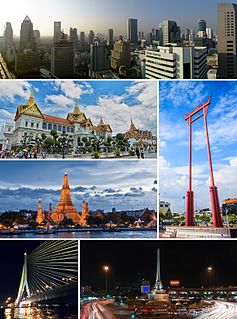
Bangkok is the capital and most populous city of Thailand. It is known in Thai as Krung Thep Maha Nakhon or simply Krung Thep. The city occupies 1,568.7 square kilometres (605.7 sq mi) in the Chao Phraya River delta in central Thailand, and has a population of over eight million, or 12.6 percent of the country's population. Over fourteen million people lived within the surrounding Bangkok Metropolitan Region at the 2010 census, making Bangkok the nation's primate city, significantly dwarfing Thailand's other urban centres in terms of importance.

Constantine Phaulkon, also known as Κωσταντής Γεράκης or Costantin Gerachi, Constantino Falcão in Portuguese and simply as Monsieur Constance in French, was a Greek adventurer, who became prime counsellor to King Narai of Ayutthaya, assuming the Thai noble title Chao PhrayaWichayen (เจ้าพระยาวิชาเยนทร์).

Desfarges, when he learned of the crisis, started to move his troops to the capital Lopburi at the request of Phaulkon, but then retreated back to Bangkok when he learned of the king's death on July 11, 1688. Phaulkon was arrested, tortured and executed by the insurgents. [4] In June, the French troops in Mergui had to be evacuated, and in September, Desfarges, besieged in Bangkok, negotiated for his troops to be evacuated to Pondicherry after the four month Siege of Bangkok. He had, however, to leave his two sons and the Roman Catholic Bishops of the country as hostages. [5]
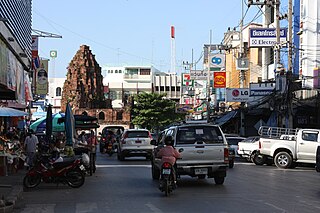
Lopburi is the capital city of Lopburi Province in Thailand. It is about 150 kilometres (93 mi) northeast of Bangkok. As of 2006 it had a population of 26,500. The town covers the whole tambon Tha Hin and parts of Thale Chup Son of Mueang Lopburi District, a total area of 6.85 km².

Puducherry, formerly known as Pondicherry, is a union territory in India. It was formed out of four exclaves of former French India, namely Pondichéry, Karikal (Karaikal), Mahé and Yanam (Yanam). It is named after the largest district, Puducherry. Historically known as Pondicherry (Pāṇṭiccēri), the territory changed its official name to Puducherry (Putuccēri) on 20 September 2006.

The Siege of Bangkok was a key event of the Siamese revolution of 1688, in which the Kingdom of Siam ousted the French from Siam. Following a coup d'état, in which the pro-Western king Narai was replaced by Phetracha, Siamese troops besieged the French fortress in Bangkok for four months. The Siamese were able to muster about 40,000 troops, equipped with cannon, against the entrenched 200 French troops, but the military confrontation proved inconclusive. Tensions between the two belligerents progressively subsided, and finally a negotiated settlement was reached allowing the French to leave the country.
In the latter part of 1689, Desfarges captured the island of Phuket in an attempt to restore French control. [1]
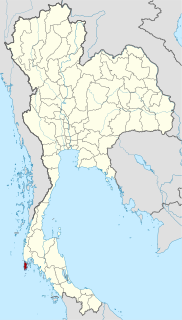
Phuket is one of the southern provinces (changwat) of Thailand. It consists of the island of Phuket, the country's largest island, and another 32 smaller islands off its coast. It lies off the west coast of Thailand in the Andaman Sea. Phuket Island is connected by the Sarasin Bridge to Phang Nga Province to the north. The next nearest province is Krabi, to the east across Phang Nga Bay.
Desfarges finally returned to Pondicherry with his men in February 1690. Part of his troops remained in Pondicherry to strengthen the French presence there.
Desfarges left in March 1690, but died of illness on his way back to France on board the Oriflamme. He was widely attacked for his role in the Siamese debacle. His own version of the events was published anonymously in 1691. [6]
The French commander Abraham Duquesne-Guiton would be involved with Siam in 1691.


